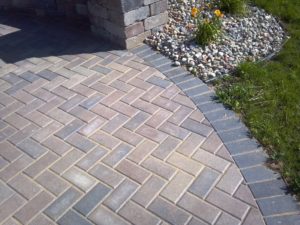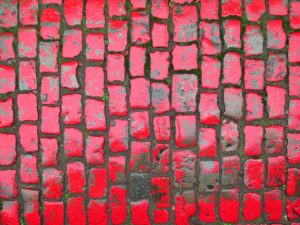Few hardscape elements are as good as pavers. They are reliable, resistant, aesthetically appealing and have the best cost benefit in the market. A beautiful paver patio is the dream of many homeowners. So what are the best practices when it comes to the drainage under pavers?
In a paver installation, proper drainage is everything. It can make or break the entire project. Without proper drainage, even the best quality pavers will eventually start to be damaged. Moreover, the entire installation can shift around and lose that good-looking characteristic paver aspect.
So let’s talk about why drainage is so important for a paver installation and how to best approach it.

Importance of Drainage Under Pavers
Pavers work in an interlocked system. That means they work alongside sand to create a malleable surface that distributes weight between each individual paver. That way, pavers are under less pressure individually and can perform optimally.
So, in a paver installation, the pavers shift around slightly. But when not installed properly, they can end up moving too much and compromising the entire structure. Drainage is a big factor in determining the success of a paver installation.
With bad drainage, the bedding and the sand between the pavers will be washed away. This is the main cause of sunken and loose pavers and the growth of weeds between the pavers. You want to avoid that at all costs, so focusing on proper drainage can be the difference between a failed and a successful installation.
Ensuring Proper Drainage
Proper Base
It all starts with planning the right materials to make the best possible base. Many people inadvertently use only sand when planning their paver base. However, a proper base consists also of geotextile fabric and gravel in addition to the sand.
After the excavation, which we will talk about next, the hole needs to be covered with geotextile fabric to make sure it will have a strong resistance again water. On top of said geotextile fabric, a 2-inch layer of gravel will be the first element of your dry installation.
This gravel is compacted in place using a plate compactor or a hand tamper. On top of that, you will add a 2-inch layer of sand, this time dispensing the need for compacting.
Slope
But before all that, you have to actually excavate the place you’re going to install your pavers on. And at this moment, there is a very simple thing you can do to make sure you have a good drainage: ensure proper slope.
At the moment of the excavation, you’re going to measure the distance of the entire area you’ll need to dig. Starting from the point that is closest to the nearest building, you’re going to add a 1/4-inch in the depth of the excavation for each foot of distance.
Installing Drain
Many people forget about storm drains when going for a paver installation. There are many options that can be installed without compromising the aesthetics of the installation. In some cases, they can be even used to compliment the design.
They are an important element for areas with clay or silt-based soil, where usually there’s a drainage is a problem.
A Bonus Alternative: Permeable Pavers
Have you ever heard of permeable pavers? In areas with drainage problems, they are the absolute best alternative. While bad drainage is an enemy of regular pavers, permeable pavers thrive on it.
Permeable pavers are designed to take advantage of the water flowing through the spaces between each paver. The installation is slightly different, with pavers placed a few inches further away for each other. Also, the bedding consists in layers of different sizes of rock, to allow the other to flow freely.
The water that flows in a permeable paver installation can be easily redirected to the sewage system. It can even be restored and recycled to be used to water plants, wash cars and other cleaning purposes.
The best part is that it is not much more expensive than a regular paver installation. A qualified hardscape professional can help you determine the best way to approach it and guide you through the whole process. And since we mentioned professionals, let’s expand on the importance of working close to one when it comes to pavers.

Professional Help With Paver Drainage
As fun as a paver installation can be as a DIY project, it can sometimes be a costly investment that you want to make sure is as perfect as possible.
A paver installation can add a ton of value to your house, and a good installation can last for years and years without causing you headaches.
A solid foundation and proper drainage are key aspects of a good paver installation, and the best way to make sure those elements are as perfect as possible, is to work closely with qualified hardscape professionals in your area.
They can guide you through the whole process, help you choose the best materials, and actually get their hands dirty with you and help you with the entire installation.
We here at S&S Pavers have helped many homeowners developing the paver patio of their dreams during our 12 years experience, so we know first the importance of having that help available. We highly recommend you get in contact with a professional on your area.
And if you happen to be around our area of activity, the Sarasota and Manatee counties, in FL, why not give us a call to help you?
You can contact us any time for a free estimate on our services. Call us right now at 941-773-3098 or email us at sales@sspavers.com. We would be happy to hear from you.




